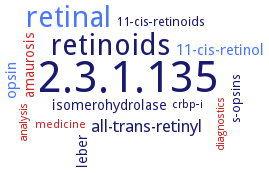2.3.1.135: phosphatidylcholine-retinol O-acyltransferase
This is an abbreviated version!
For detailed information about phosphatidylcholine-retinol O-acyltransferase, go to the full flat file.

Word Map on EC 2.3.1.135 
-
2.3.1.135
-
retinoids
-
retinal
-
all-trans-retinyl
-
opsin
-
11-cis-retinol
-
isomerohydrolase
-
amaurosis
-
leber
-
s-opsins
-
11-cis-retinoids
-
medicine
-
crbp-i
-
diagnostics
-
analysis
- 2.3.1.135
-
retinoids
- retinal
-
all-trans-retinyl
- opsin
- 11-cis-retinol
-
isomerohydrolase
- amaurosis
-
leber
-
s-opsins
-
11-cis-retinoids
- medicine
-
crbp-i
- diagnostics
- analysis
Reaction
Synonyms
11-cis-acyl-CoA:retinol O-acyltransferase, acyltransferase, lecithin-retinol, EC 5.2.1.3, lecithin retinol acyl transferase, lecithin retinol acyltransferase, lecithin-retinol acyltransferase, lecithin/retinol acyltransferase, lecithin: retinol acyltransferase, lecithin:retinol acyl transferase, lecithin:retinol acyltransferase, LRAT, More, retinyl ester synthase, retinyl-ester synthase
ECTree
Advanced search results
Source Tissue
Source Tissue on EC 2.3.1.135 - phosphatidylcholine-retinol O-acyltransferase
Please wait a moment until all data is loaded. This message will disappear when all data is loaded.
-
neoplastic and adjacent, non-neoplastic glandular breast tissue specimens from human patients, expression analysis, reduced enzyme expression, LRAT protein progressively decreases with a reduction in the degree of tumor differentiation in invasive breast carcinomas, overview

-
LRAT acts together with Cyp26A1, one of the enzymes that catalyze the degradation of retinoic acid, and possibly with STRA6, the cell surface receptor for retinol-retinol-binding protein, in maintaining adequate levels of retinoids in embryonic and extraembryonic tissues

additional information
-
expression in lens and lens epithelium and fibers from embryo to adulthood

the enzyme is distributed in both hepatic stellate cells and endothelial cells of normal rodent and human liver

-
the enzyme is distributed in both hepatic stellate cells and endothelial cells of normal rodent and human liver

-
nonparenchymal cells LRAT activity is approximately 10 fold greater than the hepatocyte LRAT activity from both vitamin A-sufficient and retinoid acid treated vitamin A-depleted rats

LRAT and cellular retinol-binding protein CRBP I are well colocalized within the liver lobules of polar bears

-
GATA transcription factors are involved in the transcriptional activation of LRAT in normal human prostate epithelial cells

-
adenocarcinoma, LRAT is downregulated as a result of oncogenic transformation

-
transcriptional regulation of the human LRAT gene is aberrant in human prostate cancer cells

-
-

hepatic stellate cells shift their retinyl ester synthesizing capacity from LRAT to acyl-CoA:diacylglycerol acyltransferase DGAT1 during activation

hepatic stellate cells shift their retinyl ester synthesizing capacity from LRAT to acyl-CoA:diacylglycerol acyltransferase DGAT1 during activation

-
expression both in Sertoli and in spermatocytes marking initiation of spermatogenesis in prepubertal mice

expression of multiple mRNAs in a tissue-specific manner

additional information
-
renal tissue expression pattern, expression is higher in renal tumor than in normal tissue

additional information
-
determination of retinoid levels in liver, blood, and lung of wild-type and knockout mutant mice



 results (
results ( results (
results ( top
top






